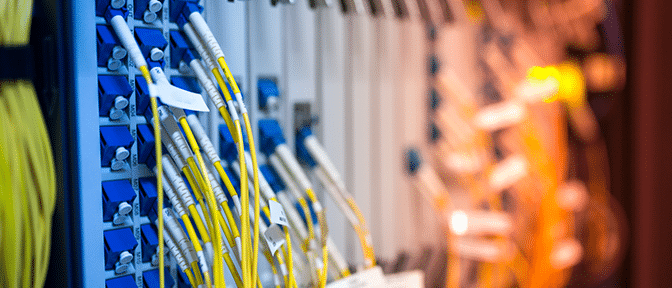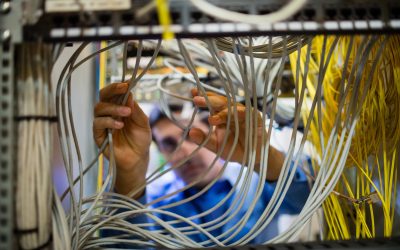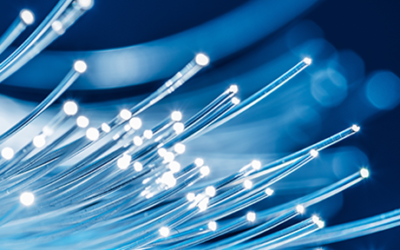7 Important Parameters of Optical Fiber

Tags: cabling | data networks | FTTh | FTTx
Cabling infrastructure is integral to ensuring effective networks today. Alongside aspects such as wireless (WiFi and Cellular) infrastructure and structured cabling infrastructure design; it’s important that infrastructure professionals understand fiber optic products to create more productive and effective networks.
Understand optical fiber to be more productive and effective:
Of course, for those working with fiber optics to make the right choice, and ensure productivity and effectiveness, it pays to know the language. While that may sound straightforward, with optical transmission, technical talk about data rates, bandwidth, loss, fiber core size and distances supported can be misleading.
To help, here are seven terms that anyone working with fiber optics needs to know about and understand:
1. CHANNEL OR LINK LOSS
Channel or link loss is the total path loss or attenuation between the transmitter and receiver is the sum of various loss mechanisms: scattering, microbending, macrobending and interconnection. These limit the maximum system length and the number of connections allowed.

2. SCATTERING
Scattering causes the intrinsic fiber loss dominated by what is known as Rayleigh scattering, which results from variations in density and compositions of the glass. This loss varies with the wavelengths of light applied.
3. MICROBENDS AND MACROBENDS
A microbend is a local deflection of the optical fiber axis, with amplitude much less than the optical fiber diameter. Microbends can cause a light ray to strike the fiber core-cladding interface at an extensive angle, allowing it to escape and increase loss. A macrobend is a bend or loop in the fiber with a radius of curvature of several millimeters or more, causing power to be lost from the core and inducing additional loss.
4. INTERCONNECTION LOSS
Interconnection loss associated with splices and connectors can be divided into intrinsic and extrinsic loss. Intrinsic mechanisms are a result of manufacturing tolerances on fiber core diameter, ovality, eccentricity and numerical aperture. Extrinsic mechanisms depend on the connection hardware and its ability to control separation between the fiber ends. Transverse, axial and angular misalignment of the fiber cores result in connector insertion loss.
5. INTERSYMBOL INTERFERENCE (ISI)
Within the optical fiber, bits of data are represented by pulses of light. Each pulse of light will spread, or disperse, over time as it travels along the length of the fiber. When these spreading pulses overlap, intersymbol interference results. The less intersymbol interference caused by dispersion, the greater the fiber’s capacity to transmit information. There are two main types of dispersion in optical fiber in the local network environment.
6. CHROMATIC DISPERSION
Chromatic dispersion describes the tendency for different wavelengths to travel at different speeds in a fiber. If operated at wavelengths where chromatic dispersion is high, optical pulses tend to broaden as a function of time or distance and cause intersymbol interference. Although multimode fiber exhibits relatively high chromatic dispersion at the 850 nm wavelength, the use of controlled launch lasers (VCSELs) in gigabit networks and the distances in the LAN minimize the effects.
7. MODAL DISPERSION
In multimode fiber systems the majority of the dispersion is caused by modal dispersion. Modal dispersion exists because the different light rays (modes) have a different optical path length along the fiber, therefore rays entering at the same time will not arrive at the far end of the fiber at the same time. Light travels faster in the low-index regions near the cladding and slower in the high-index regions near the center of the core. This dispersion effect limits the bandwidth as shown in the illustrations.
Get the Passive Infrastructure Training You Need to Improve Your Network
As optical fiber forms just one aspect of wider passive infrastructure, it’s important to have an understanding of all components to ensure network success.
To help you meet the increasing demands for network infrastructure, the Cabling Science Institute courses cover every aspect you need to know; from RF Wireless Infrastructure Fundamentals, to Fiber Optic Infrastructure, to Structured Cabling Design and more. You can take a look at the full course listing here.

Written by James Donovan
You might also enjoy
FO Connector Contamination – A Constant Threat
Fiber optic communication most commonly works in duplex or multifiber transmission by transmitting light to a receiver in one direction on a fiber and receiving transmitted light back to a second receiver on the second fiber. Most engineers can understand that and...
Why Inspect and Clean Fiber Optic Connectors?
Inspecting and cleaning of fiber optic connectors during installation and when making any patching, is essential. Any contamination on a patch cord connector will be transferred through the coupler to the connector it is mated to. Even when testing fibers with a test...
Cleaning MPOs
MPO connectors should always be inspected with a scope before they are used, be that on a patch cord or a bulkhead. If they need to be cleaned, one-click cleaners are keyed to ensure the tip only fits one way onto the connectors and is able to clean both male and...


